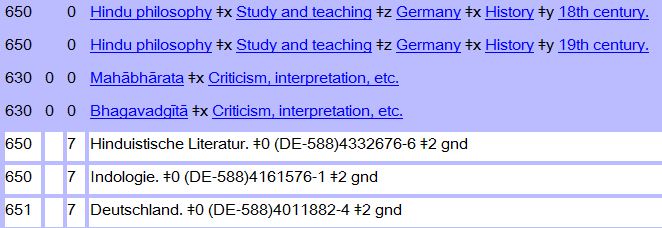A message went out to the Program for Cooperative Cataloging (PCC) listserv announcing the appointment of the PCC Task Group on URIs in MARC. The Task Force was formed to “help fulfill our strategic objective to optimize library data for the web” (email from Kate Harcourt to PCCLIST, 8 September 2015).
The group’s charge is available online (.docx). In brief, the group’s objective is to find ways to “transition from string-based descriptive and authority data.”
Those working in an OCLC environment may have already seen URIs in MARC. In order to transition to linked library data, the German National Library (DNB), regularly adds the MARC subfield 0 to access points in MARC bibliographic records. Below is a screenshot of OCLC record 827841368.

The information in subfield 0 contains a code identifying the authority file in parentheses, immediately followed by the authority record control number for the vocabulary term. DE-588 refers to the German National Library’s Integrated Authority File–Gemeinsame Normdatei (GND), which is available as linked data.
Subjects and names selected from authority files are the first obvious identifiers that might be included in bibliographic records; however, those aren’t the only terms selected from controlled vocabularies. Task Force charge #4 addresses “other” entities and relationships expressed in bibliographic records that would be better treated as identifiers. For instance, all RDA Relationship Designators (Appendices I, J, K, M, and eventually L) are terms that might be referenced with URIs, as all RDA element and vocabulary terms are available in the Library of Congress Linked Data Service and/or the Open Metadata Registry. The URI for “Sequel to“, as it might appear in a subfield i of a 7XX field, would become a machine-actionable link between the 1st book in a series and a 2nd book in a series. So much more of our RDA data (e.g., RDA carrier types or RDA media types) could be referenced by URIs.
Quoting again from the charge: “Providing URIs in MARC records will greatly facilitate the reuse of MARC data as linked data and opens the way for catalogers to work with entity registries and controlled vocabularies from the larger metadata community.”
Leave a Reply